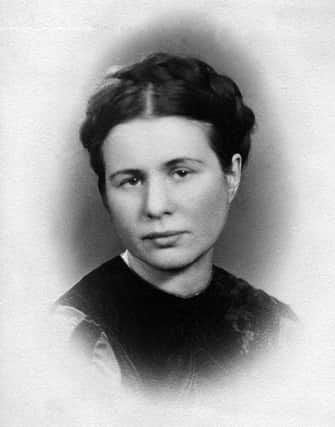Commemorating heroism on Holocaust Memorial Day


This is Holocaust Memorial Day, with millions of people around the world remembering the Holocaust and subsequent genocides.
Today’s global theme is Don’t Stand By, illustrated by an unnerving quotation attributed to Albert Einstein - “the world is a dangerous place not because of those who do evil, but because of those who look on and do nothing.”
Advertisement
Hide AdAdvertisement
Hide AdThere were countless acts of unimaginable courage during WWII by people who didn’t stand by and who risked, and often sacrificed, their lives, saving Jews from Hitler’s genocide.
Along with well-known rescuers like German industrialist Oskar Schindler and Kindertransport organiser Sir Nicholas Winton, there were many lesser remembered WWII heroes.
Polish nurse and social-worker Irena Sendler smuggled around 2,500 Jewish children out of the horrendous Warsaw ghetto in 1943.
Irena and her small team of rescuers provided their youthful exodus with false identity documents, food and shelter, and new life when death was looming close.
Advertisement
Hide AdAdvertisement
Hide AdIt’s thought that about 400 of the children were directly smuggled from danger by Sendler herself.
Though tortured and sentenced to death by the Gestapo she evaded execution and survived the war.
Englishman Francis ‘Frank’ Foley worked for the Foreign Office in Germany.
The small, slightly overweight, round-spectacled civil servant (thought to have had family roots in Roscommon) was in fact Britain’s most senior Secret Service spy in Berlin where he saved an estimated 10,000 German Jews after Hitler and the Nazi Party came to power in 1933.
Advertisement
Hide AdAdvertisement
Hide AdHe even hid Jews in his own home under the noses of the Nazis!
With Denmark’s controversial parliamentary vote on asylum seekers currently in the headlines, there’s a modern art sculpture in Jerusalem that tells a poignant tale of Danish heroism during the Holocaust.
Many of today’s migrants cross the Mediterranean in flimsy boats, and tragically, many die in the process.
Jerusalem’s boat-shaped sculpture commemorates thousands of ‘boat-people’ who were ferried in tiny vessels from Nazi-occupied Denmark to Sweden in 1943.
Advertisement
Hide AdAdvertisement
Hide AdAlso commemorated by plaques in Jerusalem’s Denmark Square, the life-saving flotilla has become known as Little Dunkirk, and many cities and towns in Israel have a street or square commemorating the heroism of the Danes.
There’s even a little wooden boat in Jerusalem’s Holocaust Museum that rowed its cargo of fleeing Jews across the bows of Nazi patrol boats.
The extraordinary mass-escape by sea was made possible because almost the entire population of Denmark’s 8,000 Jews had been tipped off about German plans to deport them to concentration camps.
From little ports and small sea-side villages, courageous Danish sailors and boat-owners carried refugees in their rowing boats, canoes, yachts and fishing vessels past German patrols to safety in Sweden.
Advertisement
Hide AdAdvertisement
Hide AdA mass Gestapo raid on Denmark’s Jews, scheduled for September 1, 1943, left the very surprised German secret police with only several hundred prisoners.
A few days earlier, Georg Duckwitz, a German naval attaché at the German embassy in Copenhagen, tipped off Danish Labour party politician Hans Hedtoft about the impending raid.
Hedtoft, later to become Denmark’s Prime Minister, warned the Jewish community to leave.
Copenhagen Synagogue’s Rabbi Melchior and his wife Lilian telephoned coded warnings that were relayed around the imperilled Jewish community.
Advertisement
Hide AdAdvertisement
Hide AdThe Rabbi’s son Bent Melchior who was 14 years old in 1943 recounted the story several years ago. “My parents were worried the phone might be tapped. So my mum started ringing other Jewish families, encouraging them to ‘take a
holiday in the countryside’. She told them we were also going away for a few days as we hadn’t had a holiday that year.”
During a New Year service in his synagogue Bent Melchior’s father told his congregation to go into hiding and to spread the word to other Jews.
Thousands of Jews urgently fled their homes to the coast where they hid until darkness fell and then met up with their courageous ferry-men.
Advertisement
Hide AdAdvertisement
Hide AdThey were smuggled and transported out of Denmark over the Øresund Strait to Sweden - a passage of varying time depending on the specific route and the weather, but averaging under an hour on the choppy winter sea. Some were
transported in larger fishing boats, but others were carried to freedom in rowboats or kayaks.
Often there were German spotter planes in the air, and enemy patrol boats on the water, so the frightened passengers hid below deck or under rugs while their sea-going saviours acted as inconspicuously as they could.
Gustav Goldberger was a nine-year-old boy when he and his parents and three brothers waded through the cold October sea and clambered into the hold of a tiny fishing boat.
Advertisement
Hide AdAdvertisement
Hide AdThe Goldbergers’ voyage took three hours because the boat-owner regularly stopped his vessel to fish, looking like he was going about his routine work.
To this day, freedom smells like fish for Gustav Goldberger!
Leif Wassermann was five years old when his parents, grandparents and younger sister climbed into the dark hull of a boat in the middle of the night. He too remembered the rotten smell of fish!
Their boat was regularly boarded by German soldiers but the Wassermanns weren’t discovered. Most refugees had to pay quite a hefty fee for their trip to Sweden and the Wassermann’s boat made more than a dozen trips with groups
of five to 20 people crammed inside the hull.
In one night 2,500 Jews sailed to Sweden. Some even swam! Over a period of about 10 days 95 per cent of Denmark’s Jewish population escaped by boat from the Holocaust.